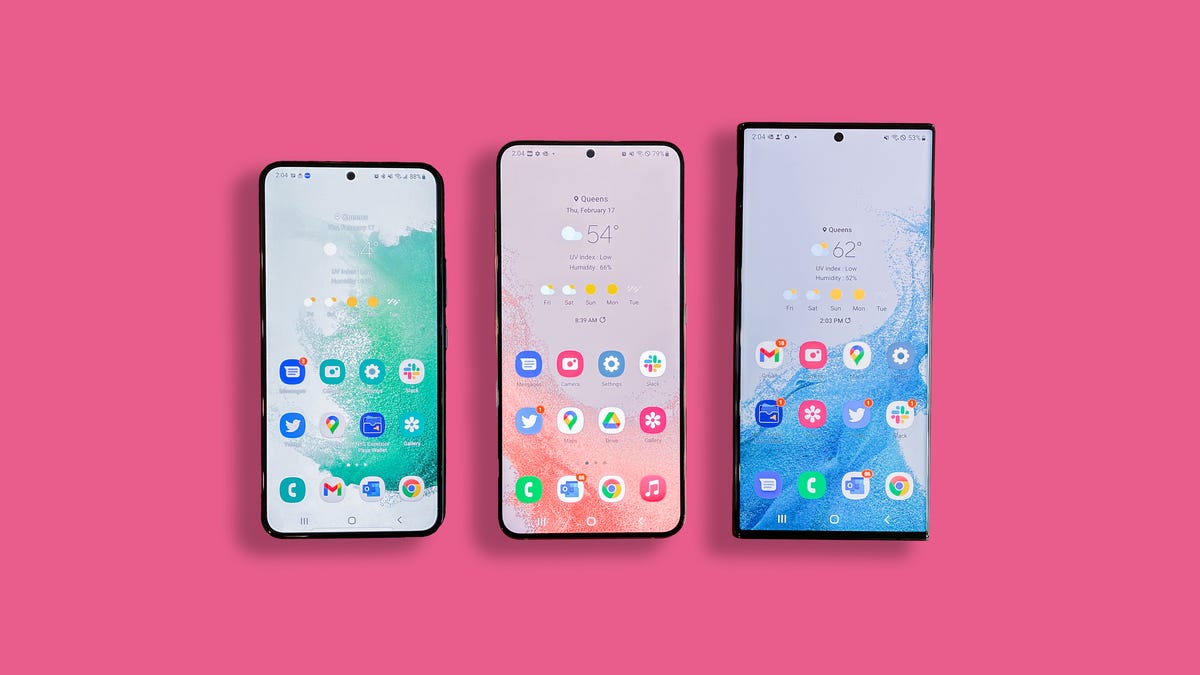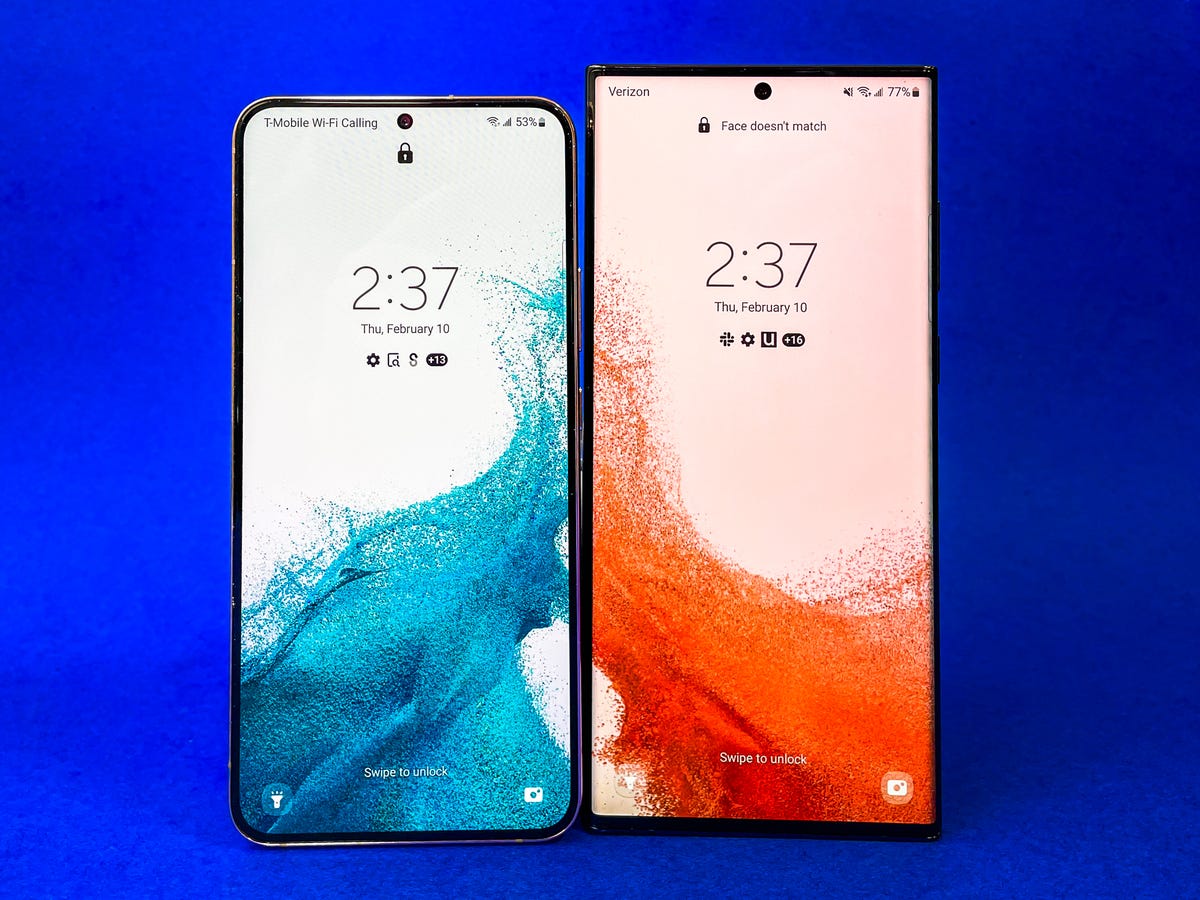Technologies
Samsung Galaxy S23: The Biggest Features I Want to See
Commentary: The Galaxy S23 needs longer battery life, more useful camera features and faster charging.

The Galaxy S22 is a modest but appreciated upgrade over the Galaxy S21, bringing refinements like a brighter screen, better camera with improved night mode and a more attractive design. Such advancements are to be expected from the world’s biggest smartphone-maker. According to Counterpoint Research, Samsung captured 21% of the worldwide market in the second quarter of 2022. However, as inflation weakens demand for new electronics, even giants like Samsung might have to work harder to drive new smartphone purchases.
And there’s plenty of room for Samsung’s phones to evolve, especially as they face increased competition from Google’s Pixel family. Samsung typically releases new Galaxy S devices in the first couple of months of the year, meaning we can likely expect the Galaxy S23 to arrive in January or February.
I hope the new Galaxy family gets longer-lasting batteries and more photography features that make use of the S line’s excellent cameras. I’d also like for Samsung to end its practice of charging a premium to take advantage of the Galaxy S22’s fast charging speeds, since the power adapter is sold separately. The Galaxy S22 lineup already provides a lot of value for Android fans, but these improvements could help Samsung take the Galaxy S23 to the next level.
Here’s everything I’d like Samsung to add and upgrade for the Galaxy S23 family.
Longer battery life for the regular Galaxy S23

The Galaxy S22
Lisa Eadicicco/CNETBattery life can never be long enough, but the standard-issue Galaxy S device is in particular need of a boost. The 6.1-inch Galaxy S22 generally lived up to Samsung’s claims of all-day battery life, but sometimes just barely. After using it for a month straight, I noticed the battery level dipped roughly to 30% or 40% by 9 p.m., even with the always-on display turned off and the screen’s refresh rate set to standard. That’s enough to get through a work day, but you’ll likely want to pack a charger if you have after-work plans or a long commute home.
The Galaxy S22 has the smallest battery (3,700-mAh capacity) of the three phones in the Galaxy S22 lineup, and it shows. For example, I was pleasantly surprised when the 6.6-inch Galaxy S22 Plus, which has a larger 4,500-mAh capacity, lasted for about a day and a half when I reviewed it in February. I also had the refresh rate set to high, which typically drains battery more quickly. The Galaxy S22 Ultra, which has a 6.8-inch screen and a 5,000-mAh battery, had similar battery life.
It makes sense that the Galaxy S22 line’s smallest phone would also have the smallest battery. But I hope Samsung finds a way to improve battery life on next year’s 6.1-inch Galaxy phone, whether it’s through better power efficiency or a larger physical battery. After all, Apple made upgrades to the iPhone 13 Mini that gave it an extra two to three hours of battery life compared to the iPhone 12 Mini. Battery life is the main complaint I had about the Galaxy S22, and addressing that would make the Galaxy S23 an even more compelling choice for Android fans who prefer smaller phones.
Korean news outlet The Elec indicates that could indeed be the case, as it reports that Samsung aims to increase the Galaxy S23’s battery capacity by about 5%.
More clever camera features

The cameras on the Galaxy S22 (top), Galaxy S22 Plus (middle) and Galaxy S22 Ultra (bottom)
Lisa Eadicicco/CNETThe Galaxy S22’s 50-megapixel camera and the Galaxy S22 Ultra’s 108-megapixel camera capture impressively colorful and detailed photos. I only wish there was more you could do with those cameras when it comes to editing and software features.
The Galaxy S22 lineup has shooting options like panorama, night mode, portrait mode, slow motion, super slow motion and Director’s View, which lets you record video using two different lenses simultaneously. Then there’s Single Take, which creates multiple stylized shots with a single press of the shutter button. You can also download the Expert Raw app to get more granular control over photo settings.
But not much has changed between the Galaxy S21 and Galaxy S22 when it comes to camera features and shooting modes. I’d love to see Samsung take a page from Google, which regularly adds nifty camera tricks that feel practical rather than gimmicky. For example, Google introduced a new feature on the Pixel 7 and 7 Pro called Photo Unblur, which sharpens low-quality photos, even ones taken with an older camera. Photo Unblur builds on Face Unblur, a previous Pixel 6 and 6 Pro camera feature I also appreciate. As the name implies, Face Unblur freezes moving subjects that may otherwise look blurry.
Features like these show that Google is not just thinking about camera quality, but also ways to eliminate everyday annoyances with mobile photography. Many of Samsung’s updates, on the other hand, feel aimed at giving content creators more tools for capturing different types of shots and video clips.
While the Galaxy S23 likely won’t launch for another two to three months, Samsung is already making enhancements to the cameras on its current Galaxy phones. It just added a new feature to the Expert Raw app that helps stargazers take better photos of constellations, similar to Google’s Astrophotography feature for Pixel phones. There’s also a new Camera Assistant app that lets you enable or disable certain features, like a faster shutter or automatic lens switching.
Faster charging that doesn’t cost so much

The Galaxy S22 Plus (left) and Ultra (right) both support 45-watt fast charging. But you have to purchase an adapter separately.
Lisa Eadicicco/CNETThe Galaxy S22 lineup supports fast charging of up to 25 watts for the Galaxy S22 and 45 watts for the Galaxy S22 Plus and Ultra. But you have to purchase a separate charger to do so. Samsung charges $50 for the 45-watt charger and $35 for the 25-watt charger, although you can often find them for less through retailers like Amazon and Walmart. In some scenarios, I also didn’t notice much of a difference between the pricier 45-watt charger and Samsung’s less expensive 25-watt charger when powering up the Galaxy S22 Plus, which you can read more about here.
With the Galaxy S23, I’d like to see a more noticeable improvement in charging speeds, as well as more affordable charger options. The OnePlus 10 Pro, for example, offers either 65- or 80-watt fast charging depending on your region, both of which are speedier than what Samsung has to offer on paper. OnePlus also includes a compatible power adapter in the box.
Samsung and Apple stopped including power adapters in their product packaging to cut down on waste, which is an admirable cause. But I at least wish Samsung would let you choose to include a fast-charging compatible adapter as an option for a discounted price when ordering a new phone, similar to the way it lets you select a storage option or add Samsung Care Plus.
If rumors turn out to be accurate, the base Galaxy S23 model might have the same 25-watt charging speed as the Galaxy S22. That’s according to Ice Universe, a Twitter account with a history of publishing details about unreleased Samsung products.
Samsung is already doing a lot right with the Galaxy S22, particularly when it comes to software support and display quality. But as year-over-year smartphone upgrades have become more incremental than revolutionary, focusing on core elements like the camera and battery are as important as ever.
Technologies
A $20K Humanoid Robot to Help Around the House? The Price Isn’t the Only Caveat
The new Neo robot from 1X is designed to do chores. It’ll have to learn a lot from you — and about you.

It stands 5 feet, 6 inches tall, weighs about as much as a golden retriever and costs near the price of a brand-new budget car.
This is Neo, the humanoid robot. It’s billed as a personal assistant you can talk to and eventually rely on to take care of everyday tasks, such as loading the dishwasher and folding laundry.
Neo doesn’t work cheap. It’ll cost you $20,000. And even then, you’ll still have to train this new home bot.
If that sounds enticing, preorders are now open (for a mere $200 down). You’ll be signing up as an early adopter for what Neo’s maker, a California-based company called 1X, is calling a «consumer-ready humanoid.» That’s opposed to other humanoids under development from the likes of Tesla and Figure, which are, for the moment at least, more focused on factory environments.
Neo is a whole order of magnitude different from robot vacuums like those from Roomba, Eufy and Ecovacs, and embodies a long-running sci-fi fantasy of robot maids and butlers doing chores and picking up after us. If this is the future, read on for more of what’s in store.
Don’t miss any of our unbiased tech content and lab-based reviews. Add CNET as a preferred Google source.
What the Neo robot can do around the house
The pitch from 1X is that Neo can do all manner of household chores: fold laundry, run a vacuum, tidy shelves, bring in the groceries. It can open doors, climb stairs and even act as a home entertainment system.
Neo appears to move smoothly, with a soft, almost human-like gait, thanks to 1X’s tendon-driven motor system that gives it gentle motion and impressive strength. The company says it can lift up to 154 pounds and carry 55 pounds, but it is quieter than a refrigerator. It’s covered in soft materials and neutral colors, making it look less intimidating than metallic prototypes from other companies.
The company says Neo has a 4-hour runtime. Its hands are IP68-rated, meaning they’re submersible in water. It can connect via Wi-Fi, Bluetooth and 5G. For conversation, it has a built-in LLM, the same sort of AI technology that powers ChatGPT and Gemini.
The primary way to control the Neo robot will be by speaking to it, just as if it were a person in your home.
Still, Neo’s usefulness today depends heavily on how you define useful. The Wall Street Journal’s Joanna Stern got an up-close look at Neo at 1X’s headquarters and found that, at least for now, it’s largely teleoperated, meaning a human often operates it remotely using a virtual-reality headset and controllers.
«I didn’t see Neo do anything autonomously, although the company did share a video of Neo opening a door on its own,» Stern wrote.
1X CEO Bernt Børnich told her that Neo will do most things autonomously in 2026, though he also acknowledged that the quality «may lag at first.»
What you need to know about Neo and privacy
Part of what early adopters are signing up for is to let Neo learn from their environment so that future versions can operate more independently.
That learning process raises privacy and trust questions. The robot uses a mix of visual, audio and contextual intelligence — meaning it can see, hear and remember interactions with users throughout their homes.
«If you buy this product, it is because you’re OK with that social contract,» Børnich told the Journal. «It’s less about Neo instantly doing your chores and more about you helping Neo learn to do them safely and effectively.»
1X says it’s taking steps to protect your privacy: Neo listens only when it recognizes it’s being addressed, and its cameras will blur out humans. You can restrict Neo from entering or viewing specific areas of your home, and the robot will never be teleoperated without owner approval, the company says.
But inviting an AI-equipped humanoid to observe your home life isn’t a small step.
The first units will ship to customers in the US in 2026. There is a $499 monthly subscription alternative to the $20,000 full-purchase price, though that will be available at an unspecified later date. A broader international rollout is promised for 2027.
Neo’s got a long road ahead of it to live up to the expectations set by Rosie the Robot in The Jetsons way back when. But this is no Hanna-Barbera cartoon. What we’re seeing now is a much more tangible harbinger of change.
Technologies
Today’s NYT Mini Crossword Answers for Saturday, Nov. 1
Here are the answers for The New York Times Mini Crossword for Nov. 1.

Looking for the most recent Mini Crossword answer? Click here for today’s Mini Crossword hints, as well as our daily answers and hints for The New York Times Wordle, Strands, Connections and Connections: Sports Edition puzzles.
Need some help with today’s Mini Crossword? It’s the big Saturday version, so it could take some time. Read on for the answers. And if you could use some hints and guidance for daily solving, check out our Mini Crossword tips.
If you’re looking for today’s Wordle, Connections, Connections: Sports Edition and Strands answers, you can visit CNET’s NYT puzzle hints page.
Read more: Tips and Tricks for Solving The New York Times Mini Crossword
Let’s get to those Mini Crossword clues and answers.
Mini across clues and answers
1A clue: Ethically sourced, as some egg
Answer: CAGEFREE
9A clue: Residents of Tehran
Answer: IRANIANS
10A clue: Air sign?
Answer: SKYWRITE
11A clue: ___ Faire (medieval-themed festival, informally)
Answer: REN
12A clue: Athlete from Cleveland or the University of Virginia
Answer: CAVALIER
17A clue: Kind of bathing suit
Answer: ONEPIECE
18A clue: Musical whizzes
Answer: MAESTROS
Mini down clues and answers
1D clue: Certain gender identity
Answer: CIS
2D clue: Holy object sought in the first «Indiana Jones» movie
Answer: ARK
3D clue: ___ pride
Answer: GAY
4D clue: Completely surrounds
Answer: ENWRAPS
5D clue: Like a cozy campsite on a cool autumn night, say
Answer: FIRELIT
6D clue: Washington’s Mount ___, the highest peak in the Cascades
Answer: RAINIER
7D clue: Sinus-treating doctor, for short
Answer: ENT
8D clue: Opposite of WNW
Answer: ESE
12D clue: _ _ _mon URL ending
Answer: COM
13D clue: De Armas who starred in 2025’s «Ballerina»
Answer: ANA
14D clue: Shape of flying geese
Answer: VEE
15D clue: Prefix with friendly
Answer: ECO
16D clue: Restaurant booking, informally
Answer: RES
Technologies
Kim Kardashian Denies the Moon Landing and NASA Corrects Her Publicly
It’s one reality TV actor versus another, as Real World alum and acting NASA administrator Sean Duffy tells Kardashian she’s wrong.

NASA says we’ve been to the moon six times. Kim Kardashian says the first time was faked. On a recent episode of The Kardashians, the reality-show star was chatting with actress Sarah Paulson about astronaut Buzz Aldrin, the second man to walk on the moon. That’s when Kardashian revealed she doesn’t believe the 1969 moon landing is real.
Don’t miss any of our unbiased tech content and lab-based reviews. Add CNET as a preferred Google source.
In an interview, Aldrin was asked about the scariest moment of the Apollo 11 mission. Kardashian quotes his reply, «There was no scary moment because it didn’t happen. It could’ve been scary, but it wasn’t because it didn’t happen.»
It’s unclear which interview this was, or what exactly Aldrin was referring to, although it seems like he’s saying a certain frightening moment didn’t come to pass. But Kardashian took the quote to mean the entire moon landing was a hoax that Aldrin chose to reveal via that one quote.
«So I think (the moon landing) didn’t happen,» she said.
NASA acting administrator (and former participant on reality show The Real World) Sean Duffy took exception to the sentiment, replying on X «Yes, Kim Kardashian, we’ve been to the moon before…6 times!»
Yes, @KimKardashian, we’ve been to the Moon before… 6 times!
And even better: @NASAArtemis is going back under the leadership of @POTUS.
We won the last space race and we will win this one too 🇺🇸🚀
🎥: Hulu pic.twitter.com/CkexEEPFSv— NASA Acting Administrator Sean Duffy (@SecDuffyNASA) October 30, 2025
The US did in fact land on the moon on July 20, 1969, with Aldrin and fellow astronaut Neil Armstrong both walking on the lunar surface. Armstrong died in 2012. Aldrin is now 95.
In 2002, Aldrin, then 72, punched a conspiracy theorist who tried to get him to swear the moon landings was faked.
«We won the last space race and we will win this one too!» Duffy told Kardashian on X. He later invited her to an upcoming launch at Kennedy Space Center, though she did not immediately accept.
Kardashian did not respond to a request for comment.
-

 Technologies3 года ago
Technologies3 года agoTech Companies Need to Be Held Accountable for Security, Experts Say
-

 Technologies3 года ago
Technologies3 года agoBest Handheld Game Console in 2023
-

 Technologies3 года ago
Technologies3 года agoTighten Up Your VR Game With the Best Head Straps for Quest 2
-

 Technologies4 года ago
Technologies4 года agoVerum, Wickr and Threema: next generation secured messengers
-

 Technologies4 года ago
Technologies4 года agoBlack Friday 2021: The best deals on TVs, headphones, kitchenware, and more
-

 Technologies4 года ago
Technologies4 года agoGoogle to require vaccinations as Silicon Valley rethinks return-to-office policies
-

 Technologies4 года ago
Technologies4 года agoOlivia Harlan Dekker for Verum Messenger
-

 Technologies4 года ago
Technologies4 года agoiPhone 13 event: How to watch Apple’s big announcement tomorrow



